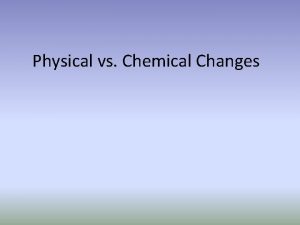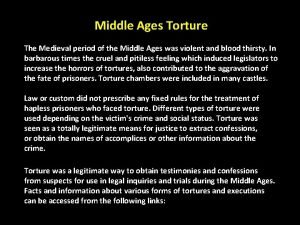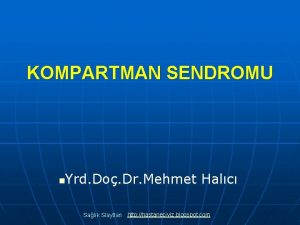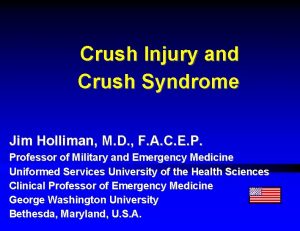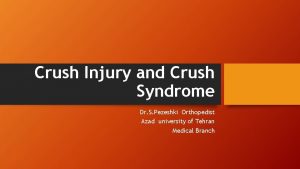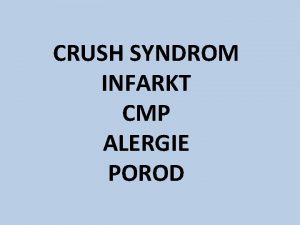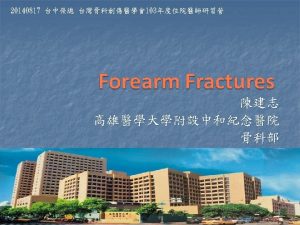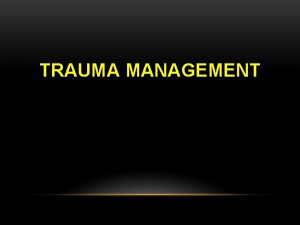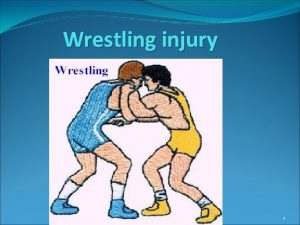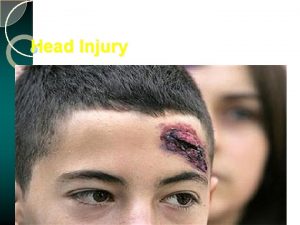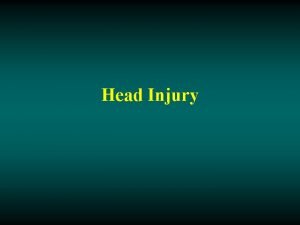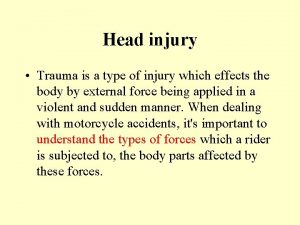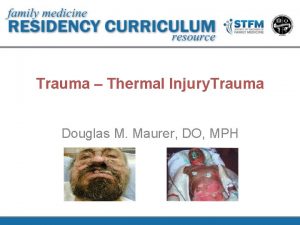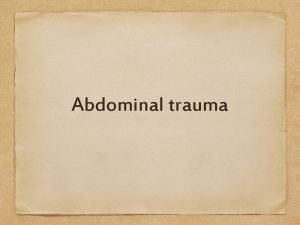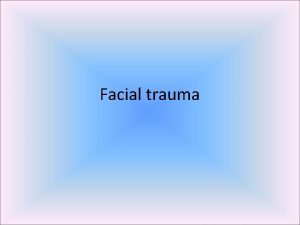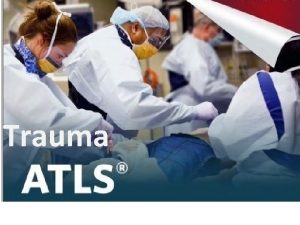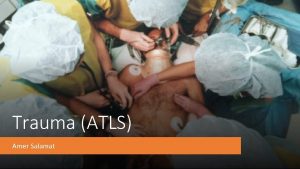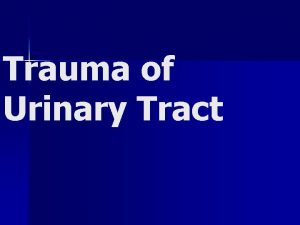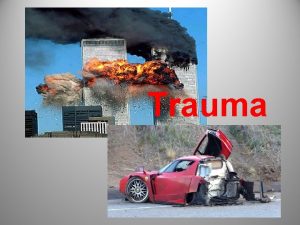Crushing Trauma and Its Aftermath Crush Injury Crush




















- Slides: 20

Crushing Trauma and Its Aftermath Crush Injury Crush Syndrome Compartment Syndrome

Crushing Mechanisms C Building & structure collapse D Earthquakes & Explosions h Motor vehicle accidents Entrapment ~ Direct impact Lack of spontaneous movement å Deep sleep ã Coma 2

Crushing Force l External crushing force applied to body s High pressure short duration 4 leg(s) s slammed between two bumpers Low pressure long duration 4 partially s buried in collapse or cave in High pressure long duration 4 generally results in amputation or death 3

Involved Anatomy l Upper extremities & pectoral girdle l Lower extremities & pelvic girdle l Other body areas generally result in immediate death Head 4 Abdomen 4 Chest 4 4

Crush Injury Cellular Response l Damage results in loss of cell membrane integrity s s l Intracellular contents spill into surrounding tissues and spaces Histamine causes vasodilation & increased capillary permeability Continued pressure impairs circulation s Local tissue hypoxia 4 Anaerobic s metabolism Build up of cellular toxins in injured tissues 4 Lactic acid, uric acid, Potassium, Phosphates, Myoglobin 5

Crush Syndrome Vascular Response l Crushing pressure sustained s l Body adapts to decreased vascular space Crushing pressures released s Blood flows into tissues (re-perfusion) redistributive hypovolemia 4 wounds in crushed limb may begin to bleed 4 l Chemicals & toxins enter systemic circulation 6

Crush Syndrome Systemic Response l Cardiovascular shock s l Third spacing - fluids leave damaged vascular space Blood chemistry is altered s Decreased p. H (increased acidity) 4 s s Increase of Lactic acid, Uric acid Hyperkalemia (increased K+) Hyperphosphatemia Hypocalcemia Increased myoglobin in blood 7

Crush Syndrome Cardiac Response l Hyperkalemia s ECG changes peaked T waves 4 widened QRS complex 4 disappearing/absent P wave 4 s Cardiac dysrhythmias heart blocks 4 V-tach 4 V-fib 4 asystole 4 8

Crush Syndrome Renal Response l Myoglobin s s Small amounts normally filtered out through kidneys Acidic environment causes myoglobin to precipitate out in kidney tubules 4 Urine becomes reddish-brown, cola colored s Causes kidney failure 9

Crush Injury/Syndrome Management l “Treatment in the rubble” s s s Treatment should be started before pressure is released Treatment may be hampered by the multicausality incident and confined space of crush injury situations Attempt to coordinate release of pressures with extrication specialists 10

Crush Injury/Syndrome Basic Treatment l Manage airway - assume dust inhalation s s s l l Wipe out mouth with damp cloth Administer O 2 via mask or provide dust filter mask Albuterol by hand-held nebulizer for wheezing Start IV in unaffected limb Hydrate both adult and pediatric patients with 20 ml/kg of NS 11

Crush Injury/Syndrome Psychological Support l Panic & agitation is common place “Don’t leave me in here” 4 “Get me out NOW!” 4 s Talk to patient Patient may get ignored during technical aspects of rescue 4 Don’t comment on future use or loss of limb 4 Field amputation by qualified MD may be necessary 4 12

Crush Syndrome Management l Indications for treatment s s l Suspicion of hyperkalemia - ECG changes Patient trapped longer than four hours Prehospital management s s s Albuterol 2. 5 mg/3 ml NS continuous inhalation Calcium chloride 1 gram IVP Sodium bicarbonate IV Infusion 4 Add 1 m. Eq/kg to first liter of NS after calcium chloride administration 13

Assessment of Crush Victims Post Rescue l Marks on victim may be minimal s s l Paralysis/weakness of affected limbs s l Mimics spinal cord injury Hypotension and tachycardia s l Keep limb(s) at heart level Use non-compressive splints Redistibutive hypovolemia Tachypnea s Metabolic acidosis 14

Assessment of Crush Victims Post Rescue l Pain or paresthesia may increase s Consider Morphine 2 - 20 mg IVP or 10 mg IM 4 Pediatrics 0. 1 mg/kg IVP or IM l Distal pulses may be absent l Progressive swelling of affected area s Compartment syndrome 15

Compartment Syndrome l Usually happens to large muscle groups such as quadriceps & gluteal muscles 16

Compartment Syndrome Pathophysiology l Fluids re-perfuse damaged areas s s Muscle tissues become swollen inside fibrous sheaths Increased swelling results in increased pressure 17

Compartment Syndrome Signs and Symptoms l General findings s s l Pallor Paralysis Pulselessness Pain on passive stretch Paresthesia Most significant findings s s Pain on passive stretch Sensory impairment 18

Compartment Syndrome Treatment l l Early recognition of developing emergency decreases disability Not treated in the field s Requires a fasciotomy to open the muscle compartment 19

Predictable Injuries and Complications s s s Direct major organ injury Lacerations Fractures Dust inhalation Crush injury Crush syndrome Compartment syndrome 20
 World war 2 and its aftermath section 3 quiz
World war 2 and its aftermath section 3 quiz Grandfather clause reconstruction
Grandfather clause reconstruction Example of intentional injury
Example of intentional injury Tyne and wear crushing contractor
Tyne and wear crushing contractor Is baking cookies a physical change
Is baking cookies a physical change Crushing tall poppies
Crushing tall poppies Knee crushing torture devices
Knee crushing torture devices Conflict aftermath example
Conflict aftermath example Beslan school siege aftermath
Beslan school siege aftermath A drunken ride a tragic aftermath summary
A drunken ride a tragic aftermath summary After math diay
After math diay I comb its hair and love its shining eyes
I comb its hair and love its shining eyes Its halloween its halloween the moon is full and bright
Its halloween its halloween the moon is full and bright When a train increases its velocity, its momentum
When a train increases its velocity, its momentum Sunny rainy cloudy windy stormy
Sunny rainy cloudy windy stormy If its square its a sonnet
If its square its a sonnet Its not easy but its worth it
Its not easy but its worth it What is katniss’ prediction as she readies herself?
What is katniss’ prediction as she readies herself? Candy crush 5084
Candy crush 5084 Candy crush 4248
Candy crush 4248 Fasiyotomi
Fasiyotomi




